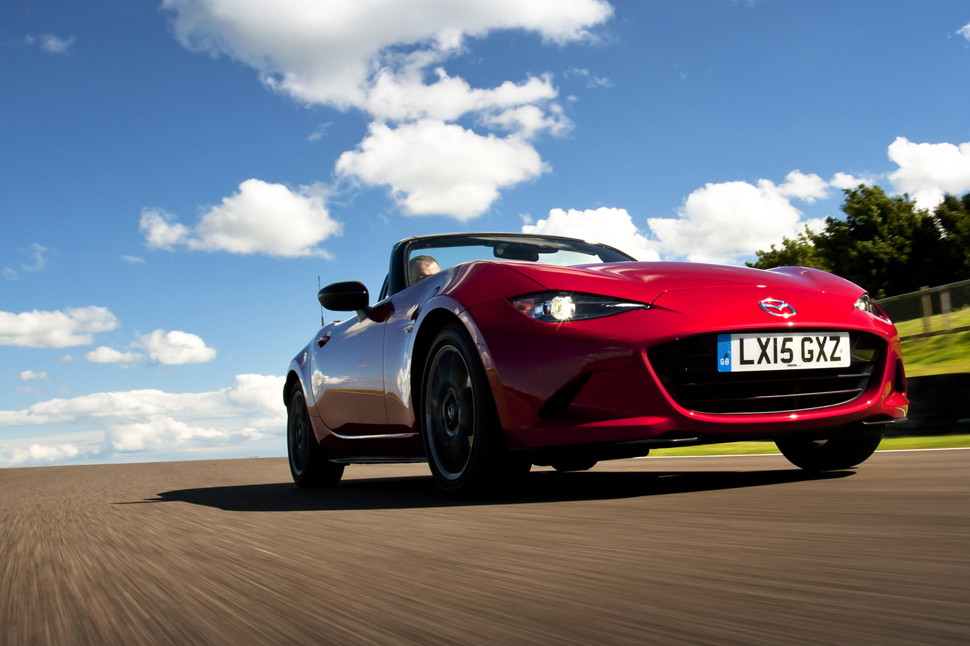


More than anything else the world’s bestselling two-seater sports car has been revered for the way it handles. This recognition of the MX-5’s agility and driver engagement was at the forefront of attention for the team developing the fourth-generation of this sports car icon. Conceived under the concept of “innovate in order to preserve” this engineering philosophy has allowed Mazda to maintain the agility, fun and engagement that has always defined the MX-5 while at the same time meeting ever-increasing safety and efficiency requirements, alongside improved refinement.
In the words of Nobuhiro Yamamoto, Programme Manager Mazda MX-5 “the MX-5 will meet and exceed the expectations of its fans around the world. It’s a car rich with charm that appeals to the emotions and to the senses. This is what I aspired to deliver with the MX-5”
And today Mazda has managed to create a lightweight sports car with unparalleled amounts of ‘Jinba Ittai’. This sense of oneness between car and driver is delivered by an MX-5 built to feel even more like an extension of the driver than ever before.
The most user-friendly generation yet, the Mazda MX-5 lifts the benchmark for handling and agility to new levels. By merging Mazda’s SKYACTIV technology of lightweight engineering and efficient engines with the MX-5’s defining roadster principles, Mazda has been able to further enhance the iconic sports car’s confidence inspiring stability and smile inducing handling.
The lightest MX-5 since the first-generation, the latest car has achieved a weight saving of over 100kg compared to the outgoing model. As before this is perfectly balanced between the front and rear of the car with the poise of 50:50 weight-distribution. The generation is not only lighter and shorter with a lower centre of gravity; it’s also stiffer and safer.
The Mazda MX-5’s SKYACTIV-Chassis retains a front double wishbone and rear multi-link suspension set-up, but extensive development has seen components reworked in the name of lightness, strength and handling precision. To enhance traction and reduce understeer the front castor angle has been increased, while to improve suspension rigidity a new truss structure has been designed for the rear cross-member. By using a portion of the body frame as the rear suspension cross-member and joining it in a truss shape, this not only improved diagonal rigidity it lowered overall weight at the same time.
Compared to the previous model, the Mazda MX-5’s suspension system is 12kg lighter with the front knuckle, plus the front upper and lower arms made from aluminium. The engine frame and rear hub supports also benefit from lightweight aluminium construction, while high-tensile steel is employed for the front cross-member. This commitment to saving every possible gram continues with the SKYACTIV-Body which features a considerably higher percentage of high-tensile steels and aluminium, which now make up 71 per cent of the body-in-white, up from 58 per cent with the outgoing car.
With front wings, bumper reinforcements and seatback bars also made of aluminium it’s clear to see the effort Mazda has made to buck the industry trend of creating bigger and heavier cars. Yet, the engineering focus was equally trained on improving chassis and body rigidity. Reinforced rear suspension towers that stifle body deformation under load, plus stronger front suspension mounts and seats mounted directly to the B-Frame to heighten local rigidity, are examples of why the Mazda MX-5 is stronger as well as lighter. The end-result is tauter body control and a more precise platform to deliver the agile handling MX-5 drivers love. Cars with the 2.0-litre 160ps SKYACTIV-G engine have a limited slip differential and strut brace, while Sport trim cars with this engine feature sports suspension with Bilstein dampers.
The latest MX-5’s new steering system also plays a big part in delivering enhanced levels of engagement and feedback. Replacing the outgoing cars hydraulic power steering set up, the fourth-generation MX-5 is the first with a space-saving dual-pinion electric power assist steering system. By placing the system closer to the front wheels and enhancing stiffness below the steering column, steering feel, linearity and precision has been improved, while a steering ratio change from 15.1 to 15.5 means the steering responds directly and quickly, just as you’d expect in a sporty roadster.
Thanks to improved brake performance the Mazda MX-5’s vented front disc and solid rear disc layout has been set-up to deliver a linier response at lower speeds but solid stopping power and reassuring pedal pressure at higher loads. With improved stability and less weight transfer under braking and when releasing the pedal, the latest MX-5 delivers greater control and improved comfort.
Match this tighter body control to higher grip levels and more agile reactions and it’s easy to see why the Mazda MX-5 is ready to capture the hearts of driving enthusiasts.Even more so when you consider the performance of the bespoke tuned SKYACTIV-G engines and the super slick shift action of the six-speed manual gearbox, working in harmony with perfectly weighted controls to deliver an unrivalled driving experience.
One that, crucially doesn’t come at the expense of comfort, as a range of measures to improve refinement mean the Mazda MX-5 sets new standards for comfort and noise suppression. The A-Pillar design, windscreen header and hood edge have all been optimised to smooth air flow and cut unpleasant wind noise, especially with the hood down. And in spite of being lighter and easier to operate than outgoing car, the soft top has been designed to absorb more noise and inhibit fluttering at speed.In fact, high-frequency cabin wind noise has been cut by around 40 per cent.
Lighter, faster and more engaging to drive than ever, the Mazda MX-5 provides the undiluted driving pleasure you’d expect from the latest version of the world’s best-selling two-seater sports car, yet at the same time it delivers never seen before levels of comfort, refinement and sophistication.
Social links
Share this
Follow us